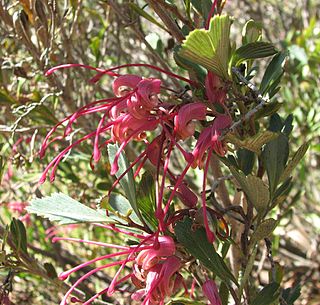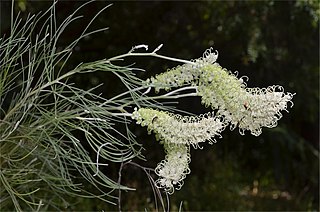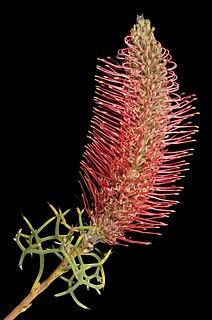
Grevillea curviloba is a species of flowering plant in the family Proteaceae and is endemic to the south-west of Western Australia. It is a prostrate to erect shrub with short branchlets, divided leaves with linear to narrowly lance-shaped lobes with the narrower end towards the base, and white to cream-coloured flowers.

Grevillea obtecta, commonly known as Fryerstown grevillea, Elphinstone grevillea or Taradale grevillea, is a species of flowering plant in the family Proteaceae and is endemic to Victoria in Australia. It is a prostrate, clumping or straggling shrub with pinnatifid, pinnatipartite or toothed leaves, and toothbrush-like clusters of light green to yellowish and purplish to black flowers with a dull yellow to pink style.

Grevillea manglesii is a species of flowering plant in the family Proteaceae and is endemic to an area around Perth in Western Australia. It is a spreading shrub with divided leaves, with triangular or linear lobes, and clusters of cream-coloured or white flowers.

Grevillea annulifera, also known as prickly plume grevillea, is a species of flowering plant in the family Proteaceae and is endemic to northern Western Australia. It is a spreading to erect shrub with pinnatisect leaves with five to nine sharply-pointed, linear lobes, and cream-coloured to pale yellow flowers.

Grevillea pteridifolia is a species of Grevillea native to Australia. Common names include silky grevillea, Darwin silky oak, ferny-leaved silky oak, fern-leaved grevillea, golden grevillea, golden tree and golden parrot tree. It occurs in Western Australia, Northern Territory, and Queensland.

Grevillea decurrens, also known as the clothes-peg tree, is a species of flowering plant in the family Proteaceae and is endemic to northern Australia. It is a shrub or tree with divided leaves, the lobes elliptic to egg-shaped with the narrower end towards the base, and conical groups of pink or cream-coloured flowers.

Grevillea pectinata, commonly known as comb-leaf grevillea, is a species of flowering plant in the family Proteaceae and is endemic to the south of Western Australia. It is a spreading shrub with divided, comb-like leaves and mauve-pink to red and cream-coloured to yellow flowers with a red to deep pink style.
Grevillea glabrescens is a species of flowering plant in the family Proteaceae and is endemic to the Northern Territory. It is an open, erect shrub with oblong leaves that have triangular teeth or lobes on the edges, and clusters of white to cream-coloured or very pale yellow flowers.

Grevillea albiflora, commonly known as white spider flower, is a species of flowering plant in the family Proteaceae and is endemic to inland eastern Australia. It is a shrub or small tree with pinnatisect leaves with linear lobes, and white to creamy-green flowers.

Grevillea glauca, commonly known as bushman's clothes peg, cobblers peg tree, beefwood tree, nut wood, nalgo, or kawoj in New Guinea, is a species of flowering plant in the family Proteaceae and is native to Papua New Guinea and north-eastern Queensland. It is an erect, spindly shrub or small tree with narrowly egg-shaped to elliptic leaves, and cylindrical clusters of cream-coloured to greenish-white flowers.
Grevillea nematophylla, commonly known as water bush or silver-leaved water bush, is a species of flowering plant in the family Proteaceae and is endemic to Australia. It is shrub or small tree with simple or pinnatisect leaves, the leaves or lobes linear, and branched, cylindrical clusters of cream-coloured flowers.

Grevillea anethifolia, commonly known as spiny cream spider flower, is a species of flowering plant in the family Proteaceae and is endemic to continental Australia. It is an erect shrub with hairy branchlets, lobed leaves, the lobes sharply pointed, and white to pale yellow or cream-coloured flowers.
Grevillea berryana is a species of flowering plant in the family Proteaceae and is endemic to the Pilbara, Mid West and Goldfields regions of Western Australia. It is a shrub or tree with mostly divided leaves with linear lobes and clusters of pale cream-coloured to yellow flowers.
Grevillea calcicola is a species of flowering plant in the family Proteaceae and is endemic to the north-west of Western Australia. It is a much-branched shrub with pinnatisect leaves with linear lobes, and off-white to cream-coloured flowers.

Grevillea calliantha, commonly known as Foote's grevillea, Cataby grevillea or black magic grevillea, is a species of flowering plant in the family Proteaceae and is endemic to a restricted part of the south-west of Western Australia. It is a spreading, compact shrub with pinnatipartite leaves with linear lobes, and pale yellow to apricot-coloured flowers with a maroon-black to reddish style.

Grevillea erythroclada, commonly called needle-leaf grevillea, is a species of flowering plant in the family Proteaceae and is endemic to northern Australia. It is a shrub or small tree with divided leaves, the ultimate lobes linear to more or less cylindrical, and clusters of cream-coloured to pale yellow flowers.

Grevillea monticola is a species of flowering plant in the family Proteaceae and is endemic to the south-west of Western Australia. It is a spreading to erect shrub with toothed to pinnatifid leaves with sometimes branched clusters of pale cream-coloured to yellowish-cream flowers.

Grevillea paradoxa, commonly known as the bottlebrush grevillea, is a species of flowering plant in the family Proteaceae and is endemic to the south-west of Western Australia. It is an erect to spreading, prickly shrub with pinnatipartite leaves, the lobes linear, widely spreading and sharply pointed, and with cylindrical clusters of pale to dark pink or cream-coloured flowers with a pinkish-red style.

Grevillea patentiloba is a species of flowering plant in the family Proteaceae and is endemic to the south-west of Western Australia. It is a prostrate to erect, spreading to straggling shrub with divided leaves, and down-turned clusters of red to deep pink and cream-coloured to bright yellow flowers with a red to deep pink style.
Grevillea dunlopii is a species of flowering plant in the family Proteaceae and is endemic to the northern part of the Northern Territory. It is a spreading shrub with divided leaves with nine to seventeen spreading lobes, and pale cream-coloured to white flowers.
















